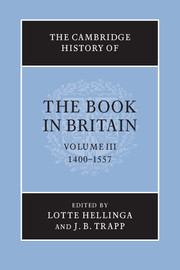Book contents
- Frontmatter
- Introduction
- 1 Literacy, books and readers
- TECHNIQUE AND TRADE
- 2 Foreign illuminators and illuminated manuscripts
- 3 Printing
- 4 Bookbinding 1400–1557
- 5 The rise of London’s book-trade
- 6 The customs rolls as documents for the printed-book trade in England
- 7 The book-trade under Edward VI and Mary I
- 8 Importation of printed books into England and Scotland
- COLLECTIONS AND OWNERSHIP
- READING AND USE OF BOOKS
- Appendix
- List of abbreviations
- Bibliography
- Photo credits
- General index
- Index of manuscripts
- Bibliographic index of printed books
- Plate Section"
- References
3 - Printing
from TECHNIQUE AND TRADE
Published online by Cambridge University Press: 28 March 2008
- Frontmatter
- Introduction
- 1 Literacy, books and readers
- TECHNIQUE AND TRADE
- 2 Foreign illuminators and illuminated manuscripts
- 3 Printing
- 4 Bookbinding 1400–1557
- 5 The rise of London’s book-trade
- 6 The customs rolls as documents for the printed-book trade in England
- 7 The book-trade under Edward VI and Mary I
- 8 Importation of printed books into England and Scotland
- COLLECTIONS AND OWNERSHIP
- READING AND USE OF BOOKS
- Appendix
- List of abbreviations
- Bibliography
- Photo credits
- General index
- Index of manuscripts
- Bibliographic index of printed books
- Plate Section"
- References
Summary
Early printers and the book-trade
In 1471, during his exile in Cologne, the art of printing first attracted the attention of William Caxton, at that time Merchant Adventurer and former Governor to the English Nation in Bruges. The technique was then still something of a novelty, though it was no longer new. In the city of Cologne a printing press had flourished since 1465, and since 1470 several other printers had set up shop. Ulrich Zell, Cologne’s first printer, had been previously associated with the earliest ventures in printing in Mainz, and remained connected with the still-expanding business of Peter Schoeffer in that city. Zell became a specialist in the production of small scholastic texts, geared to use in universities, but printed in a style much influenced by the manuscript tradition of the local monastic houses. Schoeffer, by contrast, mainly published very large folio editions of legal and patristic texts, and several editions of the Latin Bible, all intended for a market much larger than local.
Zell’s move down the Rhine was by no means the first migration of the new technique. Following its invention by Gutenberg, working in Strasbourg in the 1440s, and his first successful production of a major printed book, the famous Bible, in Mainz in the 1450s, printers leaving that city had set up presses in Bamberg and in Strasbourg. Soon after, in 1465, two other printers, clerics from the Mainz area, began printing in the monastery of Santa Scolastica in Subiaco, whence two years later they transferred themselves to Rome.
- Type
- Chapter
- Information
- The Cambridge History of the Book in Britain , pp. 65 - 108Publisher: Cambridge University PressPrint publication year: 1999
References
- 12
- Cited by

